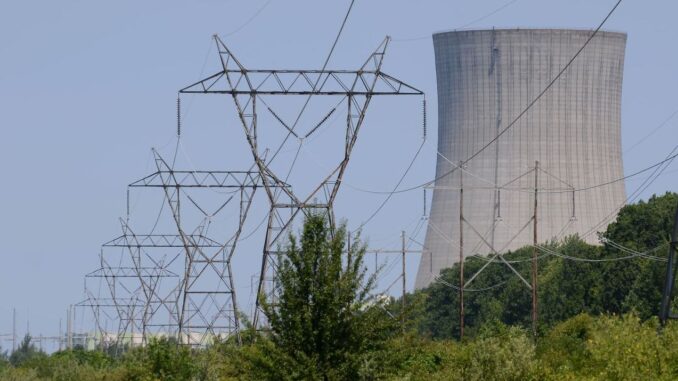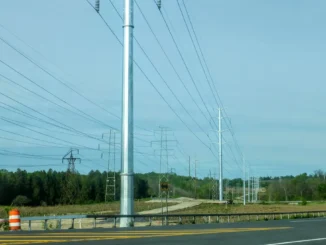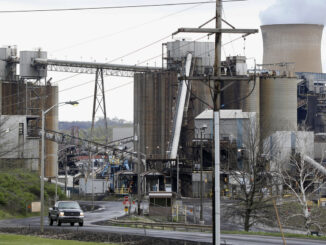
Scriba, N.Y. – Upstate New York’s largest nuclear power station is branching out into the hydrogen business in hopes of boosting its profits and its role in New York’s energy grid of the future.
Nine Mile Point Nuclear Station soon will begin using a fraction of its electric output to make hydrogen, a fuel that could one day power airplanes and trucks, heat buildings, and store energy for the power grid, among other uses.
It’s a demonstration project for now. But plant owner Constellation Energy Corp., the nation’s largest nuclear operator, anticipates that hydrogen will play an important role in the company’s future, CEO Joe Dominguez said Wednesday at the Scriba plant.
Eventually, some of Constellation’s 23 nuclear plants might devote up to half of their generating capacity to hydrogen production, Dominguez said.
“This technology is going to be incredibly important,’’ he said.
Under a wind-whipped tent near the giant cooling towner at Unit 2, Dominguez joined high-ranking state and federal energy officials Wednesday to announce the plans for Nine Mile Point.
In the short term, Nine Mile Point is undertaking two hydrogen projects:
— The first project will use 1 megawatt of electricity (out of the plant’s 1,900-megawatt generating capacity) to split water molecules into oxygen and hydrogen using a process called electrolysis. About 500 kilograms of hydrogen will be captured daily and used on site, mostly to treat the water at the plant to help prevent corrosion of the equipment. (The plant currently trucks in hydrogen from out of state for this purpose.)
The electrolysis project is being funded with $5.8 million from the U.S. Department of Energy. Nine Mile Point will be the first nuke in the country to make hydrogen, said Alice Caponiti, deputy assistant secretary.
— The second project, paid for with a $12.5 million grant from the New York State Energy Research and Development Authority, will use hydrogen produced on site to power a fuel cell. The fuel cell, to be located at the switchyard near the nuclear plant, will store energy and can send up to 10 megawatts onto the grid (enough to power 10,000 homes) during periods of peak demand, Constellation officials said.

State and federal officials anticipate a growing role for hydrogen in years to come, as the energy sector weans itself off fossil fuels. Hydrogen, which burns cleanly (giving off water vapor), has a variety of potential uses in transportation and industrial processes. And in an electric sector increasingly dominated by renewable energy, hydrogen offers a way to store energy for when solar and wind power are unavailable.
Dominguez said he expects Constellation to begin selling hydrogen by 2026. What role Nine Mile Point will play in the hydrogen economy remains to be seen. Given its position on the Great Lakes, it’s possible that the nuclear plant will one day produce compressed hydrogen and ship it abroad, Dominguez said.
State energy leaders at the Scriba event expressed enthusiasm for the role that both nuclear power and hydrogen will play as New York strives to meet aggressive carbon reduction goals. By law, the state is supposed to have a zero-emission electricity grid by 2040. Hydrogen’s role is still being assessed, but nuclear power is clearly critical to meeting the state’s goal, said Doreen Harris, president and CEO of NYSERDA.
“It’s an extraordinarily important asset,’’ Harris said. “It’s one of the reasons that we can, with a straight face, move forward with the goals that we’ve established.”
New York officials in 2016 approved big subsidies to keep the state’s Upstate nuclear facilities from shutting down amid growing financial losses.
The subsidies, paid by utility ratepayers, go to the two-reactor power station at Nine Mile Point plus the nearby Fitzpatrick reactor and the Ginna facility near Rochester. All are owned by Constellation. In addition to what the plants make selling power, they have been paid about $500 million a year collectively since 2017, according to state records.
The recently passed Inflation Reduction Act provides federal incentives for both nuclear production and hydrogen production. The federal subsidies for nuclear production will level the playing field nationally and will reduce what New York ratepayers pay, Dominguez said, without providing details.
The IRA legislation brightens the future for Constellation, Dominguez told analysts during an August conference call to discuss company earnings.
“It resets Constellation’s value as a critical infrastructure company with strong and more predictable financial results, unique growth opportunities and long-term durability on par with anyone.”
The company’s stock price has increased 53% since July 27, when Senate leaders announced their agreement to pass the Inflation Reduction Act.



